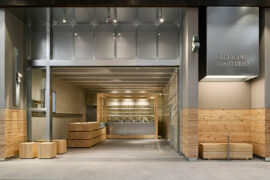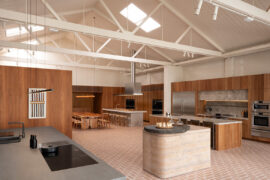In this comment piece, Brisbane-based urban designer and landscape architect Ben Newell, principal at Arcadia Landscape Architecture, suggests four ways to create a ’legacy’ games in Brisbane.

Ben Newell.
May 15th, 2023
This comment piece is written by Ben Newell, Arcadia Landscape Architecture.
In 2032 Brisbane will host the world’s first climate-positive games. It’s also set to be a ‘legacy’ games. But who’s best qualified to help the city succeed on both fronts? Designers are the answer. These are the creative professionals responsible for shaping our cities and buildings, and the public spaces that connect them, in a way that prioritises the people who use them. They’re the ‘big-picture’ thinkers who can help Brisbane make smart choices about the location, look and feel of Olympic precincts. For these sites to endure and thrive well beyond the two-week event, now is the time to turn to our talented designers.
1. Community — understanding locals’ likes & dislikes
First and foremost, I believe community consultation is key to better understanding how residents envision their own futures. To build a lasting legacy, it’s imperative that state and local government authorities firstly understand the aspirations and aggravations of how people live, work and play within their suburbs. Input and insights from First Nations’ representatives should also be prioritised.
When thinking about life in Brisbane, beyond the Olympics, my view is that flexible urban environments should be top of mind. Think sporting fields that after the games could be transformed into market venues, playgrounds or skate parks; athlete accommodation that converts to mixed-use developments with residential, retail and hospitality components.
As well as mixed-use and transport-orientated developments, I urge Olympic designers to consider a mix of housing options that reflect diverse demographics. I foresee a growing demand for affordable residential offerings in the years pre and post-Olympics, so build-to-rent developments and social housing should be in the mix.

2. Convenience — designing for easy access to popular places
The rise in work-from-home arrangements, post-pandemic, has blurred the lines between where we work and where we live. In the years that follow the Olympics, Brisbane communities will continue to crave the best of both worlds — right on their doorsteps.
To strike the right balance, I encourage designers to consider a range of land uses within easy reach of Olympic venues. Locating a mix of medical, commercial, hospitality and residential offerings within close proximity of new parklands, stadiums, and other Olympic facilities, will be key to ensuring their activation and longevity. Olympic precincts can thrive long after the games, provided they’re easily accessible to in-demand amenities and services.
Related: Bara Bridge by Sam Crawford Architects

3. Connection — convenient and comfortable transport links
Expedient and efficient transport connections are essential for an event of this magnitude but all aspects of commuting (during and after the games) need to be considered. How will people transit to and from large transport hubs? What permanent/temporary infrastructure will be put in place to make those connections easily accessible and comfortable for all ages and physical abilities?
Ours is a sub-tropical climate and, as such, we need to create shaded corridors/connections that enable people to use transport in comfort. Of course, with the games still several years away, now is the time to plant shade trees whose canopies will reach an advanced level of maturity by 2032.
For pedestrian access, I advocate for cool, shaded walkways wide enough to accommodate people, prams and mobility aids. If well planned, these are the types of routes that could be used to connect key venues in the inner city — making it easy and pleasant for people to walk to games’ events. Then, after the games conclude, these connections become thoroughfares for city dwellers and visitors seeking an easy and comfortable way to commute/explore inner Brisbane.
Additionally, we must not forget the growing popularity of new modes of transport such as scooters and electric bikes. They’re all here to stay, so we need to be clever about where and how we position cycle networks (i.e. bikeways and charging stations) within close proximity of amenities.

4. Climate — deploying design to achieve sustainability
Hosting the first ‘climate-positive’ games provides us with an exciting opportunity to show the world we’re a future-focused city. With good design as our guide, at a macro and micro level, we can ensure a legacy that’s sustainable for both our environment and our community.
As a broad directive for large, new public spaces, I believe the focus should be on minimising ‘hard’ surfaces, like concrete and dark-coloured paving, that retain and attract the heat. Where these ‘hard’ materials cannot be avoided, I recommend using temporary installations that can be removed after the games, to make way for softer, natural materials that hold less heat and promote natural cooling/ventilation.

For some precincts and facilities, the virtues of reuse versus demolition will likely be called into question. Of course, as designers, we should always be searching for sustainable solutions. But, in some instances, the resources and energy required to extract materials from an existing building or structure may be prohibitive.
At a more grassroots level, we should aim to prioritise ‘passive irrigation’ for the games’ gardens. With good guidance from engineers, kerb-and-channelling can be minimised in landscape designs, to allow water to naturally fall into garden beds — rather than congesting nearby culverts and traditional drainage systems.
For new gardens, drawing upon insights from First Nations representatives and planting endemic/native species not only helps attract local wildlife and provides them with suitable habitat, but those species are also more hardy, able to withstand drought periods and require less water and maintenance — long term.
Ben Newell has 20 years of experience and Arcadia is an award-winning landscape architecture and urban design practice with studios and shared resources spanning Sydney, Brisbane, the Sunshine Coast, Melbourne and Canberra.
Arcadia Landscape Architecture
www.arcadiala.com.au
Photography
Brett Boardman, Scott Burrows
We think you might also like this story on the UQ Reconciliation Garden.
INDESIGN is on instagram
Follow @indesignlive
A searchable and comprehensive guide for specifying leading products and their suppliers
Keep up to date with the latest and greatest from our industry BFF's!

CDK Stone’s Natasha Stengos takes us through its Alexandria Selection Centre, where stone choice becomes a sensory experience – from curated spaces, crafted details and a colour-organised selection floor.

For those who appreciate form as much as function, Gaggenau’s latest induction innovation delivers sculpted precision and effortless flexibility, disappearing seamlessly into the surface when not in use.

London-based design duo Raw Edges have joined forces with Established & Sons and Tongue & Groove to introduce Wall to Wall – a hand-stained, “living collection” that transforms parquet flooring into a canvas of colour, pattern, and possibility.

Hecker Guthrie brings a natural, material-led design to Green Cup’s new Chadstone store, pairing pine, steel and glass with a grab-and-go layout inspired by the brand’s fresh, organic ethos.

The eponymous practice founder reflects on four decades of work in a new book launched by Lord Mayor Clover Moore, tracing lessons from New York to Sydney and revisiting seminal works including 8 Chifley Square and the Andrew “Boy” Charlton Pool.
The internet never sleeps! Here's the stuff you might have missed

The Fisher and Paykel Melbourne Experience Centre by Clare Cousins Architects with Fisher and Paykel Design and Alt Group has been awarded The Retail Space at the INDE.Awards 2025. As a winning project, it redefines the possibilities of retail architecture by creating an immersive, material rich environment shaped by place, culture and craft.

Tappeti’s latest rugs have been unveiled at one of Luigi Rosselli’s stunning Sydney coastal homes alongside furniture by Design Nation.